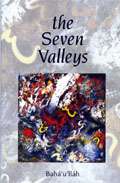The Seven Valleys
| Texts and scriptures of the Bahá'í Faith |
|---|
  |
| From the Báb |
| From Bahá'u'lláh |
| From `Abdu'l-Bahá |
| From Shoghi Effendi |
The Seven Valleys (Persian: هفت وادی Haft-Vádí) is a book written in Persian by Bahá'u'lláh, the founder of the Bahá'í Faith. The Four Valleys (Persian: چهار وادی Chahár Vádí) was also written by Bahá'u'lláh and the two books are usually published together under the title The Seven Valleys and the Four Valleys. The two books are distinctly different and have no direct relation.
Seven Valleys
The Seven Valleys was written around 1860 in Baghdad after Bahá'u'lláh had returned from the Sulaymaniyah region in Kurdistan. The work was written in response to questions posed by Shaykh Muhyi'd-Din, a judge, who was a follower of the Qádiríyyih Order of Sufism.[1] About the time of writing to Bahá'u'lláh, he quit his job, and spent the rest of his life wandering around Iraqi Kurdistan.[2]
This work has been called by Shoghi Effendi Bahá'u'lláh's "greatest mystical composition",[3] and in the West was one of the earliest available books of Bahá'u'lláh, first translated directly to French in 1905, and English in 1906.[4]
The style of The Seven Valleys is highly poetic, though not composed in verse. Nearly every line of the text contains rhymes and plays on words, which can be lost in translation. As the recipient was of Sufi origin, Bahá'u'lláh used historical and religious subtleties which sometimes used only one or a few words to refer to Qur'anic verses, traditions, and well-known poems. In English, frequent footnotes are used to convey certain background information.
The book follows the path of the soul on a spiritual journey passing through different stages, from this world to other realms which are closer to God, as first described by the 12th Century Sufi poet Farid al-Din Attar in his Conference of the Birds. Bahá'u'lláh in the work explains the meanings and the significance of the seven stages.[1] In the introduction, Bahá'u'lláh says "Some have called these Seven Valleys, and others, Seven Cities." The stages are accomplished in order, and the goal of the journey is to follow "the Right Path", "abandon the drop of life and come to the sea of the Life-Bestower", and "gaze on the Beloved". In the conclusion of the book, he mentions:
- "These journeys have no visible ending in the world of time, but the severed wayfarer—if invisible confirmation descend upon him and the Guardian of the Cause assist him—may cross these seven stages in seven steps, nay rather in seven breaths, nay rather in a single breath, if God will and desire it."[5]
In its introductory section Bahá'u'lláh refers to new age beginning with a cycle of time beginning called a Kull-i-Shay' using metaphors of the Hindu end times expectations of a Golden Age arising from age of darkness: the creation of all things (lit. Kull-i Shay') in this black and ruinous age. It is also used in the Will and Testament of the Báb[6] as well as in other Bábí contexts.[7]
The Valley of Search
The valley of search is described as the first step that a seeker must take in his path. Bahá'u'lláh states that the seeker must cleanse his heart, and not follow the paths of his forefathers. It is explained that ardour and patience are required to traverse this valley.
The Valley of Love
The next valley is the "Valley of Love". In this valley the seeker is compared to a moth who has found a flame. Bahá'u'lláh writes that the heart of the seeker is touched, and the seeker has fallen in love with God.
The Valley of Knowledge
The knowledge referred to in this valley is the knowledge of God, and not one based on learning; it is explained that pride in one's knowledge and accomplishments often disallows one to reach true understanding, which is the knowledge of God. It is explained that the seeker, when in this valley, begins to understand the mysteries contained within God's revelation, and finds wisdom in all things including when faced with pain and hardship, which he understands to be God's mercy and blessing. This valley is called the last limited valley.
The Valley of Unity
The next stage is the valley of unity, and it is explained that the seeker now sees creation not by its limitations, but sees the attributes of God in all created things. The seeker, it is written, is detached from earthly things, is not concerned with his own self and has no ego; instead he praises God for all of creation.
The Valley of Contentment
The next valley for the seeker is the valley of contentment, where it is explained, that the seeker becomes independent from all things, and even though he may look poor or is subjected to suffering, he will be endowed with wealth and power from the spiritual worlds and will inwardly be happy. Happiness is explained to be the attribute of the true believer, and it cannot be achieved by obtaining material things, since material things are transitory.
The Valley of Wonderment
In the valley of wonderment the seeker, it is written, is struck dumb by the beauty of God; the seeker becomes conscious of the vastness and glory of creation, and discovers the inner mysteries of God's revelation. Being led from one mystery of creation to the next, it is explained that the seeker continues to be astonished by the works of God.
The Valley of True Poverty and Absolute Nothingness
The final valley is the valley of true poverty and absolute nothingness, and it is the furthermost state that the mystic can reach. The seeker, it is explained is poor of all material things, and is rich in spiritual attributes. It is explained that it is the state of annihilation of self in God, but not an existential union: the essences of God's self and the mystic's self remain distinct, in contrast to what appears to be a complete union in other traditions.
See also
- The Four Valleys
- Gems of Divine Mysteries (several of the same valleys and others)
- Kitáb-i-Íqán (several of the same themes)
- Layla and Majnun
Notes
- 1 2 Taherzadeh, Adib (1976). The Revelation of Bahá'u'lláh, Volume 1: Baghdad 1853-63. Oxford, UK: George Ronald. pp. 96–99. ISBN 0-85398-270-8.
- ↑ Walbridge, John (1996). Sacred Acts, Sacred Space, Sacred Time. Oxford: George Ronald.
- ↑ Effendi, Shoghi (1944). God Passes By. Wilmette, Illinois, USA: Bahá'í Publishing Trust. p. 140. ISBN 0-87743-020-9.
- ↑ Winters, Jonah (2003-10-17). "Seven Valleys: Tablet study outline". bahai-library.org. Retrieved 2006-10-02.
- ↑ Bahá'u'lláh (1991) [1856-63]. The Seven Valleys and the Four Valleys. Wilmette, Illinois, USA: Bahá'í Publishing Trust. pp. 40–41. ISBN 0-87743-227-9.
- ↑ "Will and Testament". Bahai-library.com. Retrieved 2012-02-23.
- ↑ "Hierarchy, Authority and Eschatology in Early Bábí Thought". Bahai-library.com. Retrieved 2012-02-23.
Further reading
- Bahá'u'lláh (1991) [1856-63]. The Seven Valleys and the Four Valleys. Wilmette, Illinois, USA: Bahá'í Publishing Trust. ISBN 0-87743-227-9.
- Hatcher, J.S. (1997). The Ocean of His Words: A Reader's Guide to the Art of Bahá'u'lláh. Wilmette, Illinois, USA: Bahá'í Publishing Trust. ISBN 0-87743-259-7.
- Momen, Moojan (2001). "`Abdu'l-Bahá's Commentary on the Qur'ánic Verses Concerning the Overthrow of the Byzantines:The Stages of the Soul". Lights of Irfan. Irfan Colloquia. 2: 99–118.
- Saiedi, Nader (2000). "Chapter 3: Spiritual Journey in the Four Valleys and the Seven Valleys". Logos and Civilization - Spirit, History, and Order in the Writings of Bahá'u'lláh. USA: University Press of Maryland and Association for Baha'i Studies. pp. 79–110. ISBN 1883053609.
- Julio Savi (2008). Towards the Summit of Reality: An introduction to Bahá'u'lláh's Seven Valleys and Four Valleys. Oxford, UK: George Ronald. ISBN 978-0-85398-522-8.
External links
- Compendium on the Seven Valleys
- Planet Baha'i Mysticism Resources at the Wayback Machine (archived August 14, 2007)